Story at a glance:
- The two-level school in Westborough, Massachusetts serves students in kindergarten through third grade.
- Murals throughout the building guide students in making positive sustainable choices.
- Fales’ sloped location presented the biggest design and construction challenge for HMFH Architects.
In the middle of a forested area in Westborough, Massachusetts you’ll find a surprisingly sustainable school.
Annie E. Fales Elementary School is reported to be New England’s first net-positive energy public school—with a sawtooth roof to maximize surface area for south-facing PV panels and north facing skylights, plus 40 geothermal wells supplying heating, cooling, and hot water.
Fales boasts a predicted Energy Use Intensity (EUI) of 24.7 and can generate 11.6% more—yes, more—energy than required to power the all-electric facility. Serving around 400 kindergarten through third grade students, the school celebrates its environment and shows off the wondrous possibilities of renewable energy. Westborough itself hopes to be carbon emissions–free by 2035.
“We had goals for the actual built environment of the school that inherently lent itself to be such a robust, sustainable school,” says Caitlin Osepchuk, an associate at HMFH Architects and project architect for Fales Elementary School.
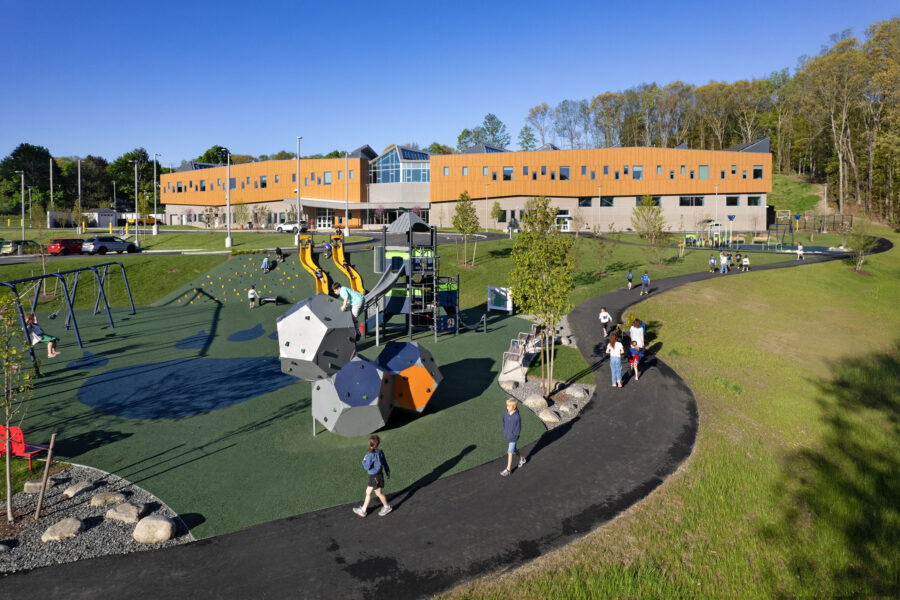
HMFH kept the palette simple for the exterior. Exterior materials included concrete block from Jolley Concrete, phenolic paneling with a wood texture roofing material, uPVC windows by Intus, and aluminum curtain wall. Photo by Ed Wonsek
However, achieving net-zero was not part of the original feasibility study. Rather, it came up in schematic design. “We were always looking for ways to limit the energy use and find healthier materials that weren’t going to off-gas as much with low VOCs for these small students,” Osepchuk says. “As we finished out feasibility and got into schematic design it was clear we could achieve net-zero energy. The town and the chair of the school building committee said, ‘As a town of Westborough, we want to push the sustainable goals. We’re designing and paying for this new school. Let’s really push the envelope and let’s make it net-zero.’”
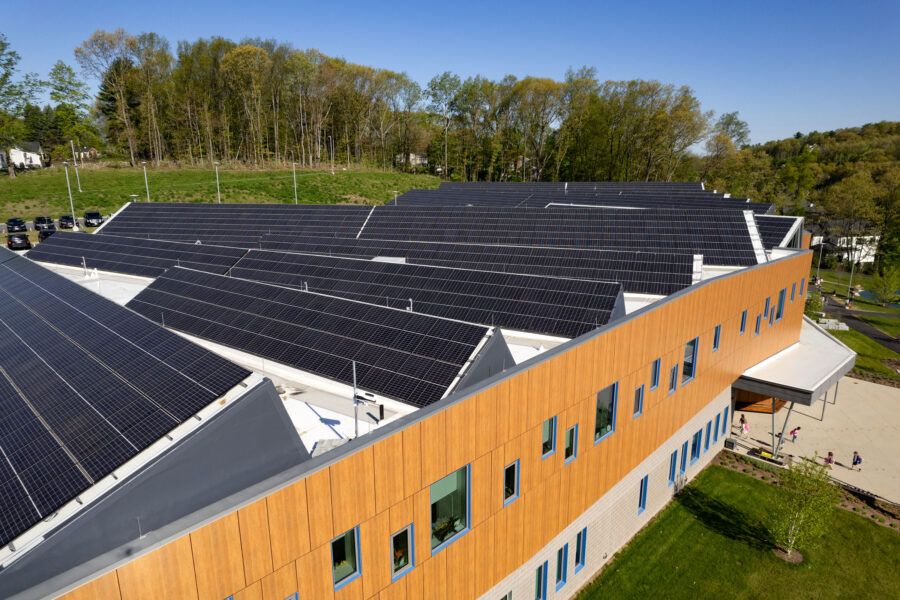
Photo by Ed Wonsek
As the design progressed efforts to limit energy use and maximize the amount of PV panels that could fit on the roof continued. The exterior incorporates CMU (concrete block), phenolic paneling—which has a wood texture and design to match the wooded landscape—roofing material, uPVC windows, and aluminum curtain wall. A neutral gray and brown face with warm flecks in it, the CMU brings out the wood coloring in the phenolic paneling. “We kept the palette pretty simple,” Osepchuk says.

HMFH projects tend to include wall graphics that function as learning opportunities. Photo by Ed Wonsek
Interior materials include linoleum flooring, paint, and phenolic paneling. Inside the two-story school, learning areas are organized into four project areas representing various landscapes: forest, meadow, marshland, and pond. They each correspond with a color palette and grade levels at the school.
Old school design was very stark and blank because everyone thought that was the way to keep kids engaged in what the teacher was lecturing about.
“Kids like a lot of color, and we like to make sure we include that in all of our school designs,” Osepchuk says. “Old school design was very stark and blank because everyone thought that was the way to keep kids engaged in what the teacher was lecturing about. Thankfully times have changed.”
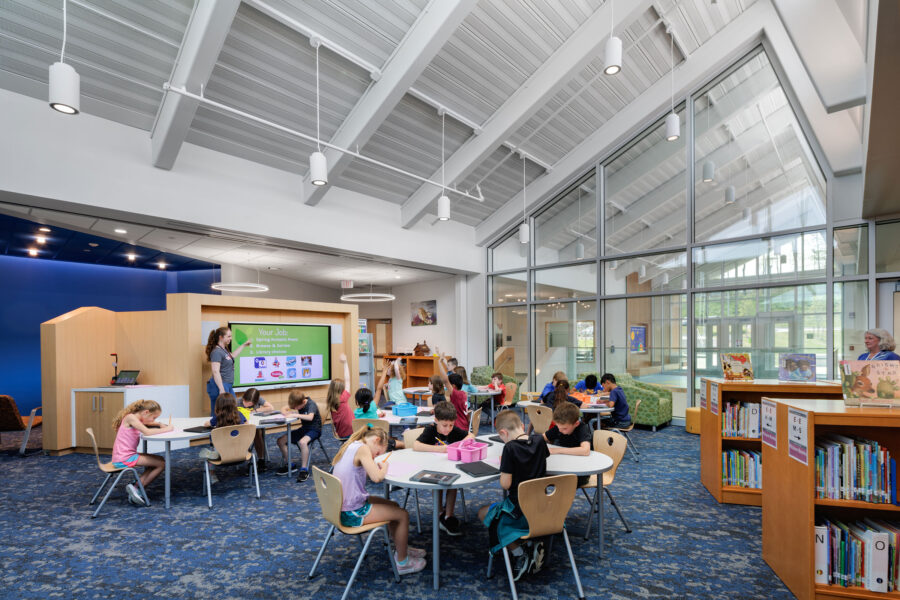
Inside, carpet manufactured by Mohawk is included in spaces like the media center—where kids might want to sit on the floor and read—and the four project areas. Each classroom has a throw carpet for storytime or other class activities. Photo by Ed Wonsek
Designed in-house, storybook-style graphics on the walls depict Fales mascot—Annie the Hedgehog—adventuring through the four local ecosystems. Throughout the day students can connect with nature by peering through clerestory windows that allow natural light into the space.
“The murals help get the students excited about where they live, wanting to get out and explore as well,” Osepchuk says. “And foster that love of the environment so they’ll continue to make positive sustainable choices in the future to help maintain the ecosystems they live in.”
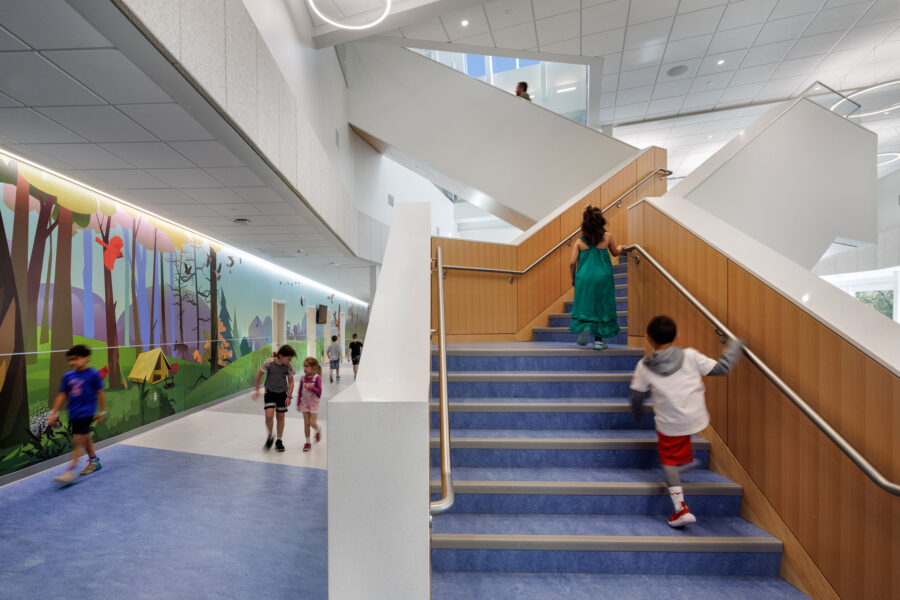
Natural light filtering through the clerestory windows helped Fales achieve net-positive energy status. While the school didn’t require as much electricity, HMFH worked with LAM Partners for indoor lighting. LAM Partners wanted to keep the light power density low while still creating and maintaining well-lit spaces. Photo by Ed Wonsek
While Fales’ scenic setting provides an intentional and aesthetic space for students to learn more about the world around them and appreciate the environment, building the school into a hill proved difficult.

Photo by Ed Wonsek
“It’s hard enough to build on a flat site. Now add in a pretty steep hill,” Osepchuk says. “It was challenging, but we used it as an opportunity to push the design and find opportunities to have a two-level school that’s accessible from the site on both the second and first floor.”
Pip Lewis, principal at HMFH Architects and project director for Fales Elementary School, says the slope impacted outdoor play areas. “One of the challenges because of the hillside was that each of these play fields needed to be made handicap accessible from the school and from the working area,” he says. “Long curving paths that connected the play areas.”
HMFH also had to be mindful of the nearby pond—a designated wetland. “One of the struggles during construction was keeping the pond clean,” Lewis says.
Completed in November 2021, the design team expects the school to stand the test of time. “We always have to choose durable materials, not only from a maintenance standpoint,” Osepchuk says. “We want to design schools that last at least 50 years.”
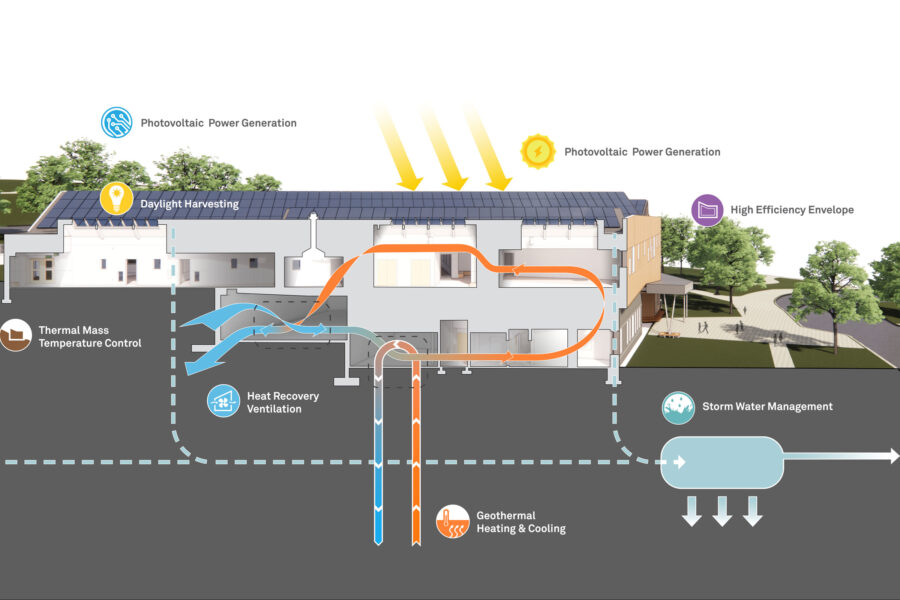
Sustainability diagram courtesy of HMFH Architects
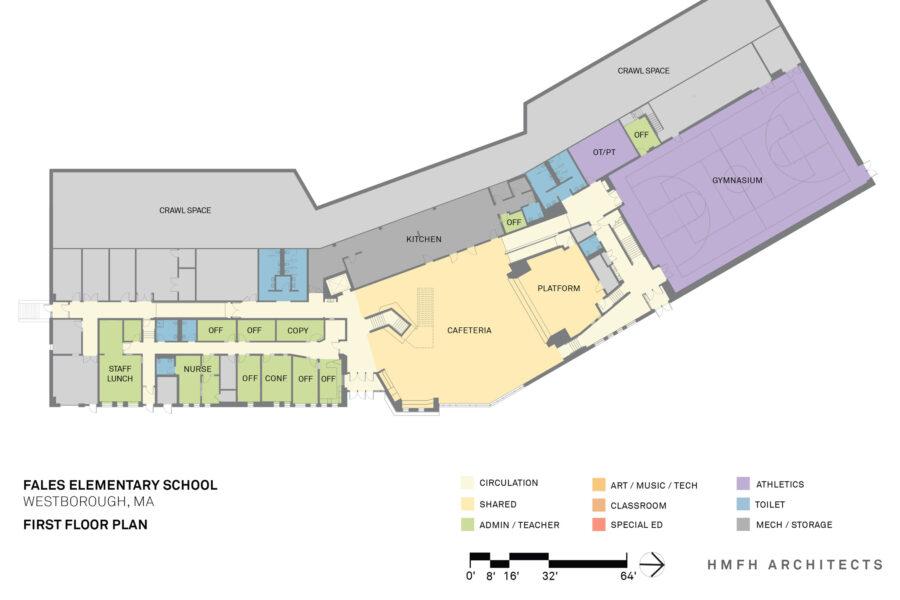
Floor plan courtesy of HMFH Architects
Project Details
Project: Annie E. Fales Elementary School
Location: Westborough, MA
Completion: November 2021
Cost: $56.8 million
Architect: HMFH Architects
Electrical, Plumbing, and Fire Protection: R.W. Sullivan
Civil Engineer: Samiotes Consultants
Lighting & HVAC Consulting: LAM Partners
Contractor: Gilbane Building Co.
Interior Designer: HMFH Architects
Landscape Architect: Crosby Schlessinger Smallridge
Specifications: Kalin Associates



